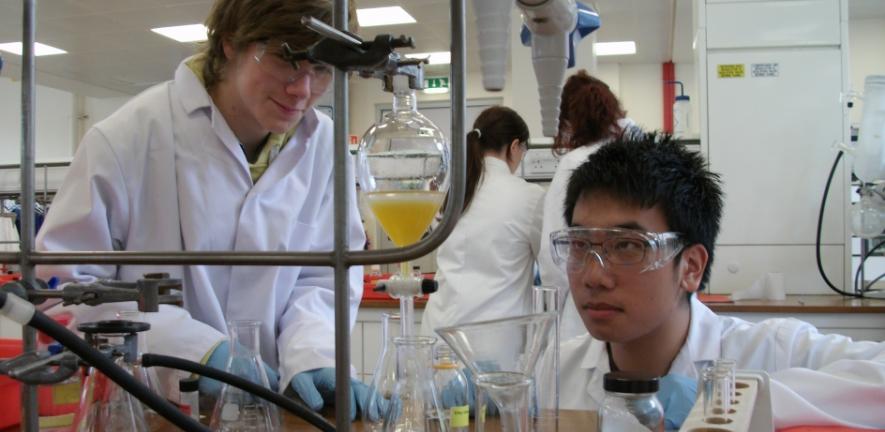
As the second hand reaches the start of a new minute, Orange Team tip their reactants into their beakers and stand back, watching the clock impatiently.
As the second hand reaches the start of a new minute, Orange Team tip their reactants into their beakers and stand back, watching the clock impatiently.
it’s fantastic for the students to have the time to really think about a problem and stretch themselves like this.
Elaine Wilson
“It’s coming up to ten seconds and nothing’s happened yet…” said Babawale Oguntoye , commentating for the benefit of those who couldn’t see. “…eleven...twelve…thirteen…”
At 15 seconds a cheer goes up as the contents of the first flask flash from colourless to dark blue.
At the Salters’ Chemistry Camp, hosted by Dr James Keeler, Director of Teaching in the University of Cambridge Department of Chemistry, six teams of students are competing to make the most accurate chemical clock.
They must mix two chemicals in the correct proportions so that the contents of each of four beakers, placed around a clock face, will change colour at 15 second intervals.
“Some teams have worked out the theory before mixing their solutions, while others are using trial and error,” explains Elaine Wilson from the Faculty of Education, Lead Teacher at the Salters Chemistry Camp. “Lessons at school have to be wrapped up in less than an hour so it’s fantastic for the students to have the time to really think about a problem and stretch themselves like this.”
120 students from schools across the UK have been selected to take part in two residential Chemistry Camps for young scientists at the collegiate University.
“The camps give the students a taste of the kind of intellectually challenging, practical activities they could enjoy studying chemistry at A-level and at university,” says Elaine.
“The Stingcurb exercise, in which the students make and purify a sample of anaesthetic, is actually a first-year undergraduate practical. By giving these young people the opportunity to work on challenging practicals alongside enthusiastic peers, graduate chemists and expert teachers, we hope to encourage their interest in the subject into A-level and beyond.”
At least one team agrees. “Nerds are the future,” declared their hand-painted sign hanging proudly above their clock. The students made the paint themselves in another exercise, this one led by Jo Christopher and supported by Anuradha Pallipurath , an expert in pigment analysis for art conservation.
The young chemists also enjoyed social activities at Churchill College, their base for their Cambridge stay, including a fun quiz and the “Search out Science in Cambridge” trail.
“The Camp is a chance for us to demonstrate that Cambridge is a diverse university that welcomes everyone, as long as they have academic talent and an appetite for their subject,” explains Elaine.
“It has been wonderful to see shared passion for chemistry turning into firm friendships among young people from very diverse schools. We hope that they will go home with renewed motivation and enthusiasm for the subject, and that some of them will be inspired to apply to Cambridge in the future. When they do, they’ll be able to say ‘I did a Salter’s Chemistry Camp and it really fired me up’”
The Salters’ Chemistry Camps at The University of Cambridge are sponsored by: The Salters’ Institute; The Association of the British Pharmaceutical Industry (ABPI); Institution of Chemical Engineers (ICHemE); The Royal Society; The Royal Society of Chemistry (RSC) and the University of Cambridge.
This work is licensed under a Creative Commons Licence. If you use this content on your site please link back to this page.

